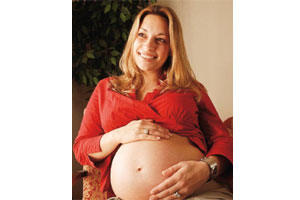As of the twelfth week of gestation, the now fetus goes through a series of noticeable changes. Not only does it triple its weight, but it also acquires a more human form (despite its head being bigger than its body). Its eyes begin to move from the sides of the face towards the front and its hands have developed fingers and fingernails.It is also important to point out that during this stage the fetus develops an important cellular network, which will allow it to relate to its surroundings. We are referring to the increase of neurons located within the brain, which, during the third month, equal the amount an adult has. Although it is an important increase, the necessary connections for the brain to command its actions don’t exist yet. Due to this, the actions the fetus performs, like making a fist or holding hands, are considered involuntary.
Second trimester
Close to the fourth month, the mother can already perceive the subtle movements of the fetus.It begins to move and flex it’s limbs joints (articulations). Its heart pumps nearly 25 liters of blood a day and its legs grow quickly, surpassing its arms in length. Fingerprints and numerous folds in the brain are developed and the ossicles of the middle ear harden as well. A fine and soft hair called lanugo covers its body. But without a doubt, the most important change occurs at the genital level, which develop and allow the identification of the baby’s sex. The fifth month brings with it a fundamental change regarding the interaction between mother and fetus. The latter is capable of performing energetic movements, detectable to tact and even visible. It is not strange for true “lumps” to form on the maternal abdomen, which can be the baby’s fists or feet. As its organs are almost formed, the fetus develops a defense system that allows it to maintain temperature (thanks to the accumulation of fat) and protect itself against some pathogen organisms (an hint of its immune system).At the end of these weeks, its appearance will be very similar to that of a newborn. Finally, during the sixth month, the fetus is already capable of recognizing some voices and sounds thanks to the full development of its ears. It sleeps nearly 20 hours a day, but performs agile movements upon awakening.
Third trimester
During the last trimester of pregnancy, the fetus gains weight considerably. Its organs are totally formed and a consolidation stage begins. At the seventh month, the strengthening and calcification of the bones begins. For this to happen, the mother must reinforce consumption of specific nutrients, like calcium folic acid and iron. The baby’s skin becomes darker and it is already capable of opening and closing its eyes (which have a light blue coloration). The correct position the fetus must adopt in order to go towards the outside is acquired during the eighth month of gestation. Although it almost has no more space to move inside the uterine cavity, it manages to twist its head in the pelvis and its buttocks onto the mother’s diaphragm (in some cases it happens the other way around, which is called the podalic position. The ninth month is a waiting month. The fetus already has all of its organs and tissues matured, so, during this period, only some traits of its features are perfected and the last step is awaited: childbirth.
Maternal physiognomy
Fetal growth produces important changes in the mother’s anatomical build. Although during the first months the transformations are not very noticeable, the inside of the maternal body goes through vital processes. During the first trimester of gestation, all of the systems adjust to pregnancy and supply the substances necessary for the development of the new being (mainly oxygen and nutrients). Certain hormones stop menstruation, the abdomen slightly increases in size and the breasts swell, becoming more sensitive. The mother’s pulse and respiratory rate increase considerably because more oxygen and nutrients are sent to the fetus. The second trimester determines a noticeable growth of the maternal abdomen, which may result in the appearance of stretch marks on the skin (furrows originated by the excessive dilation of the tissue). It is also possible that the increase in fetal size can cause back pains for the mother. In many cases, due to weight, the spine is deformed. The breast’s nipples usually get darker. The maternal heart works at twice its normal rate (supporting the circulatory and excretory work for her and the fetus). The growth of the fetus is so great during the last months that during the third trimester, the uterus takes up most of the abdomen, displacing the digestive tract and pressuring the diaphragm. The intestines are strongly squished, the same as the urinary bladder. This last situation forces the mother to urinate frequently and even present urinary incontinence. During the last months of gestation, it is probable that the mother’s breasts secrete a yellowish fluid called colostrums, thick, sticky substance that will nourish the baby hours after birth.








 Muere Evita
Muere Evita